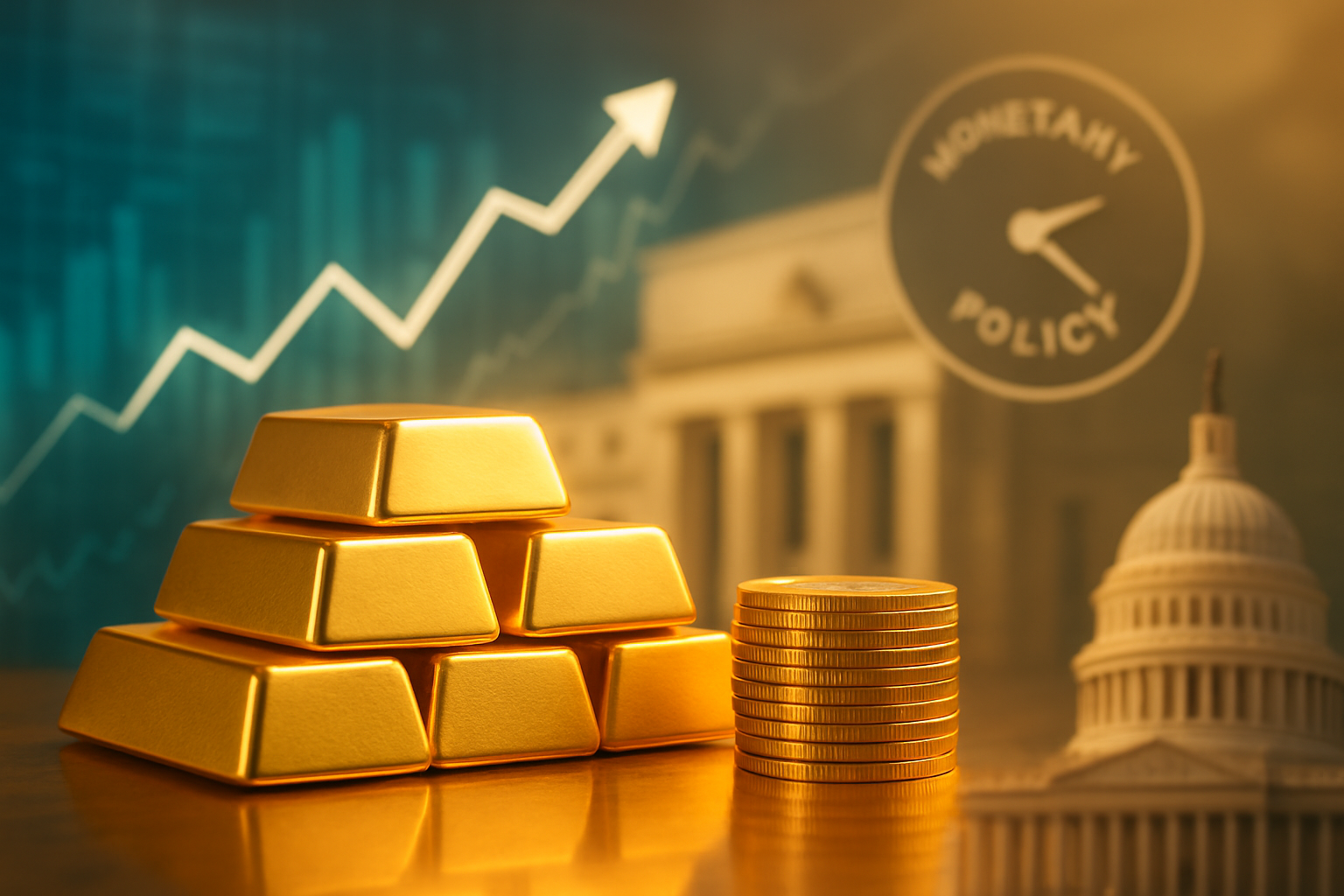
In a significant move for the precious metals market, gold prices surged to a near three-week high in early November 2025, buoyed by growing investor confidence that a potential resolution to a protracted U.S. government shutdown will pave the way for a more aggressive interest rate cutting cycle by the Federal Reserve. This rally underscores gold's enduring appeal as a safe-haven asset amidst political uncertainty and shifting monetary policy expectations, particularly as markets anticipate that delayed economic data, once released, will reinforce the necessity for monetary easing.
The financial landscape is currently dominated by the interplay of government stability, the flow of critical economic indicators, and the Federal Reserve's posture on interest rates. As the U.S. government grapples with an extended fiscal impasse, traders are increasingly betting that the eventual resumption of normal operations and the subsequent release of backlogged economic data will reveal a clearer picture of a softening economy, thus compelling the Fed to act decisively on rate cuts. This outlook has significantly reduced the opportunity cost of holding non-yielding gold, making it an attractive investment.
Prolonged Fiscal Impasse and Market Repercussions
The recent surge in gold prices to approximately $4,142.60 per ounce for spot gold and $4,149.20 per ounce for December futures, around November 10-11, 2025, is intricately linked to the unfolding drama of a U.S. government shutdown that has now stretched for over a month. This prolonged fiscal standoff, stemming from a deep legislative disagreement over appropriations, has brought significant portions of federal operations to a halt, creating a vacuum of crucial economic data and injecting considerable uncertainty into financial markets.
The timeline of events saw the shutdown begin after the October 1st deadline for appropriations bills, with Congress and the White House failing to reach a consensus. As the impasse deepened into November, the U.S. Senate emerged as a key player, advancing a funding bill aimed at reopening the federal government. This legislative effort, while still requiring House approval and presidential signature, signaled a potential pathway out of the gridlock, offering a glimmer of hope for governmental stability. Key stakeholders involved include the U.S. Congress, the White House, and ultimately, the American public and the Federal Reserve, whose policy decisions are heavily influenced by the economic environment.
Initial market reactions to the shutdown were broadly negative, extending beyond gold's safe-haven appeal. U.S. Treasury yields, particularly for shorter-term bonds, initially saw a "flight to quality" drop as investors sought the perceived safety of government debt. However, the prolonged nature of the shutdown and any potential entanglement with the debt ceiling debate could introduce upward pressure on longer-term yields due to concerns about creditworthiness. Equity markets, represented by major indices such as the S&P 500 (SPX), Dow Jones Industrial Average (DJI), and Nasdaq Composite (IXIC), experienced declines amid uncertainty over government contracts, delayed economic data, and a predicted reduction in consumer and business confidence. The CBOE Volatility Index (VIX) predictably spiked, reflecting heightened investor anxiety.
Crucially, the Federal Reserve found itself navigating a "data void" due to the shutdown, with essential economic indicators like non-farm payrolls, inflation reports, and consumer spending data being delayed or suspended. Federal Reserve Chair Jerome Powell had previously acknowledged the challenges posed by missing economic data, indicating that it could lead to a more cautious approach to rate decisions. With the anticipated end of the shutdown, the market expects a deluge of delayed data that is widely believed to paint a picture of economic weakness, thereby strengthening the argument for the Fed to implement interest rate cuts, potentially as early as their December meeting, with probabilities of a quarter-point reduction estimated between 64% and 67%.
Corporate Fortunes in a Volatile Landscape
The current confluence of rising gold prices, a U.S. government shutdown, and the prospect of Federal Reserve interest rate cuts creates a distinct landscape of winners and losers across various public companies. Understanding these dynamics is crucial for investors navigating the volatile market.
Gold mining companies stand to be direct beneficiaries of sustained high gold prices. Firms like Barrick Gold Corp. (NYSE: GOLD) or Newmont Corporation (NYSE: NEM) would see their revenues and profit margins increase significantly as the value of their primary product rises. Similarly, bullion dealers and precious metal investment firms would experience heightened demand from investors seeking safe-haven assets, boosting their sales and customer engagement. Conversely, jewelry retailers and manufacturers, such as Tiffany & Co. (NYSE: TIF), would likely face increased production costs that are often passed on to consumers, potentially leading to a decline in demand for gold jewelry. Industries relying on gold for industrial applications, like semiconductor manufacturers, could also see their input costs rise, impacting profitability.
Prolonged government shutdowns, while not creating direct "winners," inflict substantial losses on several sectors. Government contractors, such as defense and IT service providers like Lockheed Martin Corporation (NYSE: LMT) or Booz Allen Hamilton Holding Corporation (NYSE: BAH), face significant disruptions including work stoppages, payment delays, and an inability to secure new contracts. The travel and tourism industry, encompassing airlines like Delta Air Lines, Inc. (NYSE: DAL) and hotel chains, suffers from reduced travel due to staffing shortages at federal agencies (e.g., TSA, air traffic control) and closures of national parks. Retail and consumer-facing businesses, particularly those near federal offices, also experience a drop in sales as furloughed federal employees reduce discretionary spending. Small businesses, in general, face delays in permits, loans, and regulatory approvals, hindering growth.
Expectations of Federal Reserve interest rate cuts, however, bring a different set of winners. Real estate developers and homebuilders, such as D.R. Horton, Inc. (NYSE: DHI), benefit immensely from lower mortgage rates, which stimulate housing demand and make homeownership more affordable. The consumer discretionary sector, including retailers like Amazon.com, Inc. (NASDAQ: AMZN) and automotive companies, sees increased spending power as borrowing costs for credit cards and auto loans decrease. Technology and high-growth companies, often reliant on borrowing for R&D and expansion, find their cost of capital reduced, fostering further investment. Utilities, which are capital-intensive, also benefit from lower borrowing costs for infrastructure projects. Conversely, banks and financial institutions like JPMorgan Chase & Co. (NYSE: JPM) might see their net interest margins squeezed if the rates they earn on loans decline faster than the rates they pay on deposits. Life insurance companies, such as MetLife, Inc. (NYSE: MET), could also face reduced returns on their fixed-income investments in a lower-rate environment.
Broader Implications and Historical Echoes
The intricate dance between gold's ascent, the U.S. government's fiscal stability, and the Federal Reserve's monetary policy stance in November 2025 carries profound wider significance, shaping broader industry trends and casting ripple effects across global markets.
The sustained gains in gold prices, now hovering near $4,000 per ounce, underscore its enduring role as a premier safe-haven asset. This trend is not merely a reaction to the U.S. shutdown but is bolstered by deeper currents of global economic uncertainty, persistent geopolitical instability, and rising government debt worldwide. The record-high gold purchases by central banks in 2025 further solidify gold's fundamental support, indicating a systemic shift in how nations view and utilize the precious metal as a store of value and a hedge against currency depreciation. While a resolution to the U.S. shutdown may temporarily temper safe-haven demand, the underlying factors suggest continued robust interest in gold and other traditional safe havens like the Swiss franc and Japanese yen.
The imminent resolution of the U.S. government shutdown, following a 40-day fiscal impasse, offers immediate relief but also highlights a critical challenge to government stability. While a bipartisan temporary funding deal is on the table, the recurring nature of such political dysfunction erodes international confidence in the U.S.'s reliability. This contributes to "systematic political risks" that markets increasingly price in, leading to elevated volatility and potential long-term capital reallocation away from the U.S. The economic costs, including reductions in GDP growth, are cumulative, even if markets often rebound quickly post-shutdown. This suggests that while the immediate crisis may pass, the underlying political polarization remains a significant threat to sustained economic stability.
The strengthened outlook for Federal Reserve interest rate cuts, with markets pricing in a significant chance of a December reduction, is a direct response to emerging signs of a weakening U.S. economy. Recent job cuts, mirroring levels seen in the early 2000s, and pessimistic consumer sentiment indicate that the Fed's "risk management cuts" in September and October were prescient. From a monetary policy standpoint, the "data blackout" caused by the shutdown forced the Fed to rely more heavily on private economic data and qualitative assessments, complicating its decision-making process. This situation underscores the Fed's delicate balancing act between controlling inflation and supporting employment, with a clear lean towards preventing further labor market deterioration. The ongoing discussion within the Fed regarding how factors like stablecoin growth might influence the "neutral rate" also points to evolving considerations for future policy.
The ripple effects extend to other commodities and global markets. Federal Reserve rate cuts typically stimulate economic growth and weaken the U.S. dollar, generally boosting demand for raw materials like oil, industrial metals, and agricultural products. However, the impact can be nuanced, with underlying market fundamentals (e.g., oil surplus, China's slowdown) potentially offsetting some positive effects. A more widespread global trend of rate cuts would be needed for a significant and sustained boost across the commodity spectrum. Globally, the expected shutdown resolution is likely to trigger a relief rally in equity markets, while the U.S. dollar may weaken as political uncertainty subsides. However, the prolonged nature of the shutdown has undeniably tested international confidence, potentially leading to subtle, long-term shifts in global capital flows. Regulatory and policy implications are significant: the shutdown's data void highlights the need for robust alternative data sources for monetary policy, while the fragile fiscal agreements post-shutdown point to continued volatility in government-linked industries and a looming national debt crisis. Historically, while the S&P 500 has often shown resilience during shutdowns, longer impasses like the current one can lead to permanent GDP losses. Gold, conversely, has historically appreciated during such periods of political uncertainty, reinforcing its safe-haven status.
The Path Forward: Navigating a Dynamic Landscape
As the U.S. government shutdown inches towards a resolution and the Federal Reserve signals a more accommodative monetary policy, the short-term and long-term possibilities for the economy and financial markets present a complex but potentially dynamic outlook.
In the short term, the anticipated resolution of the government shutdown is expected to trigger a relief rally in equity markets, with major indices likely to see a positive bounce as political uncertainty subsides and government services resume. This immediate economic impact of a shutdown, including a reduction in GDP growth and disruptions for federal employees, will begin to reverse. Concurrently, the strengthened rate cut outlook by the Fed, potentially leading to a December cut, will translate into lower borrowing costs for consumers and businesses. This could stimulate consumer spending on big-ticket items and encourage business investment in R&D and expansion, benefiting growth-oriented sectors like technology and consumer discretionary. However, financial services may face margin pressure if lending rates fall faster than deposit rates.
Looking further ahead, the long-term trajectory hinges on whether these rate cuts are merely a response to temporary weakness or indicative of deeper economic challenges. An optimistic scenario sees the shutdown resolution removing a significant headwind, with rate cuts successfully stimulating a steady economic recovery, rebounding GDP, and a more robust labor market. Conversely, if the underlying economic weakness persists, the stimulus might prove insufficient, leading to stagnation, or even a recession, especially if compounded by recurring fiscal drag and high national debt. A "K-shaped" recovery, where asset holders and high-income households disproportionately benefit from lower rates while others struggle, remains a possibility, exacerbating economic inequalities. For financial markets, a sustained relief rally could support equities, though volatility may persist. Bond prices will likely remain supported by lower rates, while the U.S. dollar could weaken, boosting dollar-denominated commodities.
Strategic pivots and adaptations will be crucial for both investors and businesses. Investors should prioritize diversification across asset classes and geographies to manage risk amidst potential volatility. Sector rotation, balancing growth stocks with defensive sectors, will be key. Monitoring the resumption of government economic data will be paramount for informed decision-making. Businesses, on their part, must focus on financial resilience by building cash reserves and managing debt prudently. Diversifying revenue streams, enhancing customer retention, and investing in technology and innovation will be vital for navigating economic shifts and maintaining agility. Supply chain resilience, through diversified supplier networks, will also be critical in mitigating future disruptions.
Market Moving Forward: A Balanced Perspective
The current landscape, marked by gold's safe-haven surge, the impending resolution of a U.S. government shutdown, and the Federal Reserve's dovish pivot, paints a picture of a market at a significant inflection point. The key takeaways from this period underscore the profound impact of government stability and monetary policy on investor sentiment and asset valuations. Gold's rally to a near three-week high serves as a clear indicator of market anxiety and a flight to safety, while the Fed's strengthened rate cut outlook signals an acknowledgment of underlying economic softening.
Moving forward, the market will be keenly assessing the efficacy of the Fed's monetary easing in stimulating sustainable growth without reigniting inflationary pressures. The resolution of the government shutdown, while providing immediate relief, does not eradicate the systemic political risks that have become a recurring feature of the U.S. fiscal landscape. Investors should anticipate continued volatility stemming from these political dynamics and the inherent uncertainty of economic data, particularly as the backlog of government statistics is released.
Final thoughts on the significance and lasting impact suggest that this period could mark a shift towards a lower interest rate environment, potentially recalibrating valuations across various asset classes. The enduring appeal of safe-haven assets like gold will likely persist as geopolitical tensions and domestic fiscal uncertainties remain. What investors should watch for in the coming months includes the Federal Reserve's subsequent policy statements and economic projections, the actual impact of rate cuts on consumer spending and business investment, and any further legislative developments regarding long-term fiscal stability. The interplay between these factors will ultimately determine the market's trajectory and the broader economic health.
This content is intended for informational purposes only and is not financial advice





